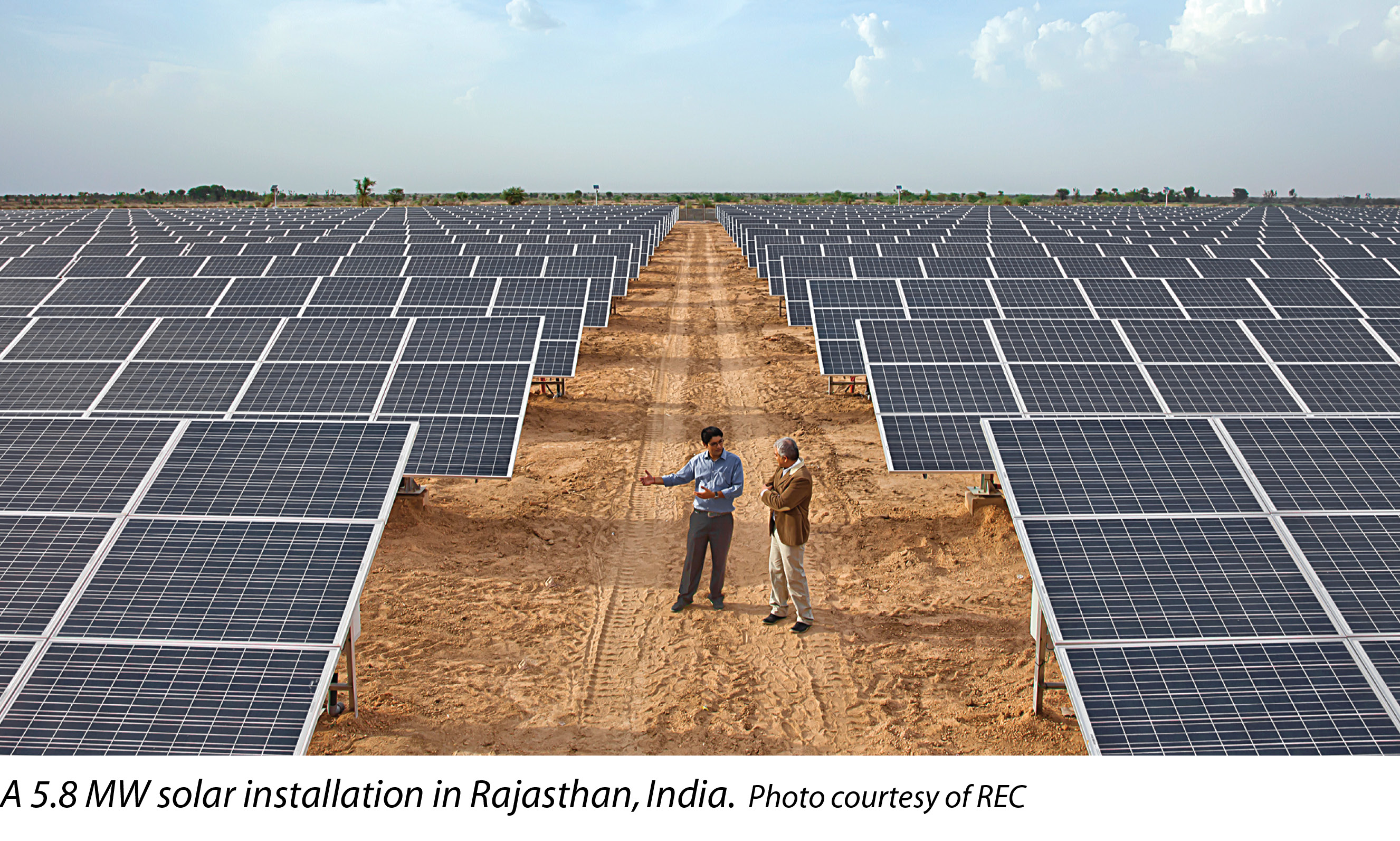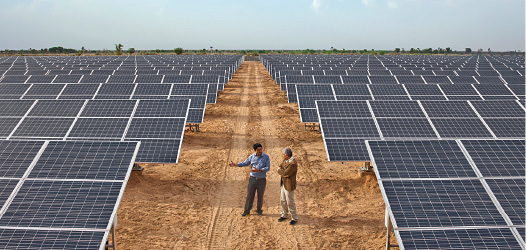

301 Moved Permanently
A June report from the United Nations Environment Program says global solar photovoltaic capacity reached 100 GW in 2012, surpassing biomass to become the third largest renewable power source after hydropower and wind. Bloomberg New Energy Finance (BNEF) says it expects the global PV market to total 37.0 GW of new capacity this year, compared to 30.5 GW in 2012.
However, the factors that drive solar demand around the world are extremely dependent on the conditions in the various markets. Consumers of solar power in an industrialized economy have very different priorities than those in a developing economy.
Mature market
In North America, where the supply of electricity is not a serious issue, the main driver for solar demand is financial and will remain so for the foreseeable future.
“In terms of what we can control directly, we remain very bullish on the solar sector in the U.S.,” says Paul Winnowski, president and CEO of Mainstream Energy Corp., based in San Luis Obispo, Calif. “The industry is poised for substantial growth.”
In Winnowski’s view, the solar business is moving into a phase where business practices - the direct control - are having a significant impact on how customers approach the product. Energy costs plus well-publicized incentives in the form of tax rebates and utility programs have made the experience of buying residential solar akin to buying a car. This is exactly the sort of model he is striving to develop.
As a business, the technology for delivering solar power is pervasive and reliable enough in North America that providers of solar products and services can focus on honing their own costs and crafting a “showroom” experience for customers.
“Customer service and lead generation are our drivers,” Winnowski says. “These are things we can control.”
Nevertheless, of indirect drivers, Winnowski says net energy metering (NEM) has been absolutely critical to getting the solar sector off and running as a commercial enterprise.
“Net metering is the dynamic that has let the business grow,” he says. “Rolling back the meter for what you can produce is a very powerful selling point.”
The future of NEM is perhaps the most important “known unknown” the solar sector faces. In July, a proposal by the Arizona Public Service Corp. to state regulators asking for solar fees and a re-evaluation of NEM policies touched off a storm of protest from regional installers and solar service providers. Colorado’s Xcel Energy has also signaled its unhappiness with NEM, and this has produced more outrage from solar advocates, including the Solar Energy Industries Association and the Vote Solar Initiative.
“Net metering is one of the things that keeps us up at night,” Winnowski says. “If the plug gets pulled, it’s a big problem for solar.”

Utilities are not always on the other side of the equation. Winnowski cites recent actions by the Sacramento Municipal Utility District (SMUD) and the Long Island Power Authority (LIPA) as examples of how utilities are getting smart about solar.
“Solar is most effective where people need it and when people need it,” he says, noting that additional loads can be met by adding distributed solar generation capacity without a major investment in conventional generation, transmission and distribution. SMUD has signed multiple 20-year power purchase agreements (PPAs) with Recurrent Energy for 60 MW of solar power in the southern portion of Sacramento County. In July, LIPA crafted a feed-in tariff (FIT) program to promote the development of solar power in a high-demand area of its service territory.
“Load growth, particularly at peak times, is a serious issue on the South Fork of Long Island,” says Michael Deering, LIPA’s vice president for environmental affairs. “The added value of solar is that we can defer transmission and distribution costs.”
Beyond incentives, Winnowski says leasing programs, perhaps another parallel with the automobile industry, have lowered the barrier for consumers. The notion of being able to acquire a solar power system with no money down along with a service and maintenance contract appeals to homeowners.
Ethan Miller, Mainstream Energy’s vice president of regional business, agrees that leasing programs and PPAs for homeowners have fueled a lot of recent growth.
“Financial leasing programs have resonated,” Miller says. “Consumers want no risk.”
Sam Chatterjee, director of project finance at Borrego Solar, a San Diego-based developer and financier, agrees that market dynamics are currently favoring the solar sector and producing a very strong effect on demand. He also cites the advent of funds that target solar projects as reducing the cost of capital for financing them.
“From my point of view, solar is becoming more acceptable to the financial community,” Chatterjee says. “Distributed generation has a lot of potential. The cost of panels, of course, has dropped, but other components are getting cheaper, too. There is a constant incremental improvement in technology.”
The idea that solar power development has achieved a level of maturity where project financing and management are the key drivers of a successful deployment is attractive from the standpoint of investors.
“Like any business, developers have to have a good sense of what projects are going to be attractive,” Chatterjee says. “It’s all about risk. You need to know what would make a deal unworkable. A well-managed solar project is not that risky.”
Solar struggles
The solar market in the U.K. offers a sharp contrast to the one in North America. According to Leonie Greene, manager of external relations for the Solar Trade Association (STA), the U.K.’s solar sector really only dates back to 2010 with the start of the popular FIT scheme, which focuses on domestic installations. At the utility scale, she says, the government’s Renewables Obligation to encourage power generation from renewable sources has really only been a boon to solar since last year, when solar became more cost-effective than offshore wind.
“Solar capacity now stands at 2.7 GW in the U.K., with 420,000 domestic installations making for the majority of capacity,” Greene says. “Since last year, we’ve seen about 600-800 MW of solar farms. So, solar is behind other technologies in terms of capacity but catching up.”
Nevertheless, Greene points out that the U.K. lags behind Germany’s 33 GW, Italy’s 16 GW and France’s 5 GW of installed solar capacity.
“The energy minister, Greg Barker, wants to see one million solar homes by 2015, so we are not on track, currently installing around 100,000 per annum,” she says.
Greene says the utility sector has been rocked by the major European Union trade dispute with China over solar panels and the prospect of prices being set by Brussels at a level around 20% higher than today.
“Actually, this risks leaving the U.K. support framework out of kilter with real-world costs,” she says. “It’s a real problem, particularly next year when support is set to drop again.”
To top it off, solar farms have attracted negative political and media attention in the U.K. A member of Parliament recently described solar farms as creating an “industrial wasteland” in the famously bucolic countryside. The STA is concerned that poor examples of solar installations are damaging the industry’s reputation and has publicly called on developers to put more focus on siting issues.
“A recent poll by the STA found strong public support for good- quality schemes,” Greene says. “The frustration is that many Liberal Democrat and Conservative ministers are talking more positively about shale gas than solar. This is out of step with the public view.”
In what is essentially a new industry, Greene says government programs are important for getting solar up to par with other developed economies. In particular, she points to constraints in the U.K.’s FIT scheme on solar projects over 50 kW.
“That is why there is very little deployment at the mid-scale in the U.K. market,” Greene says. “The STA is pushing hard for this to be addressed.”
One bright spot Greene cites is the 5 MW Westmill Solar Co-Operative, the first community- owned solar farm in the U.K. She hopes the facility can serve as a model for additional community projects.
Emerging greatness
A June report from IHS expects PV installations in Asia this year to exceed 15 GW and thus account for 45% of global demand, making the Asian market larger than Europe for the first time. According to BNEF, Japan is expected to see between 6.9 GW and 9.4 GW of new-build PV this year as it seeks to replace output from its off-line nuclear reactors. China’s government has announced plans to boost its goal for solar power installations by 2015 from 21 GW to 35 GW, partly in an effort to reduce smog.
While China and Japan are both experiencing rapid growth in solar capacity, many point to the developing world as the emerging agent of global solar demand. An August report from IHS says a sustained increase in PV capacity from emerging economies will be enough to produce a recovery in manufacturing capital investment in 2014.
The example of India is instructive of how local conditions in a large developing economy produce solar sector growth with characteristics that are very different than in the established industrial world. According to Shailendra Mohan Bebortha, managing director of REC India, the country has an infrastructure that is unable to keep pace with energy demand. The nationwide blackout in India in July 2012 was reportedly the greatest power outage in history. Its impact was felt by over 600 million people, with an estimated capacity loss of 32 GW.
“India knows what will happen if the country remains excessively reliant on a centralized grid and fossil fuels,” Bebortha says. “Given the huge demand for electricity and the country’s high irradiation levels, the outlook for India’s solar market is very positive.”
Reliable access to power, then, is a major driver in India, and Bebortha sees strong growth in the utility-scale solar market, with growing opportunities in rooftop commercial and industrial sectors. Outside of the country’s major urban areas, Bebortha says there are opportunities to electrify remote regions and replace or complement diesel installations, which are nowhere near as cost-efficient as solar energy.
The cost of a unit of power from an off-grid solar system is $0.18 to $0.21 per kWh - lower than power from diesel generators, which is $0.30 to $0.33 per kWh or higher. Moreover, Bebortha points out, solar energy is actually available when needed during peak hours - in strong contrast to grid power, where an overloaded network can fail precisely when it is needed most.
The average residential electricity tariff in India is $0.07 per kWh and is highly subsidized by the state. Thus, Bebortha says, the prices of solar power are typically too high for residential self-consumption, and this market segment needs to have an incentive scheme in place. The current average grid-connected utility-scale solar FIT is approximately $0.13 per kWh. This is currently very close to the average power tariff in the commercial segment, which is about $0.11 per kWh.
“Solar is fast reaching grid parity in certain segments, such as utility scale and commercial consumers, especially those that use diesel as a backup source,” Bebortha says.
Mercom Capital Group, a market research firm based in Austin, Texas, reports there has been a total of 622 MW of solar installations in India in the first seven months of this year, with only 73 MW installed since May. According to Mercom Capital CEO Raj Prabhu, there is a growing concern among institutions that are funding or looking to fund solar projects in India about requirements for state customers to meet the lowest bid. Under such “race to the bottom” practices, banks see very thin margins and are concerned that developers will be tempted to cut corners, causing a negative effect on project quality. Prabhu says the government must have payment-guarantee mechanisms to give solar financiers more confidence.
“Feed-in tariffs, exchange-traded renewable energy certificates, as well as financial incentives, are still needed in this young market for grid-connected solar power to be viable,” says REC India’s Bebortha. “However, with the increasing electricity cost in India, we believe the reliance on these incentives for setting up solar power plants will be reduced in the future. Moreover, fixed solar expansion targets help to trigger solar investments and will lead to sustainable growth.”
Nearly all players in the solar sector point to the continued importance of government in promoting growth worldwide. Whether this is the 30% tax credit that will be reviewed by the U.S. Congress or renewables obligations enacted in the U.K. and India, there is no denying government’s hand in creating a viable solar sector. Perhaps one day the invisible hand will take over, but the current drivers of the global solar market suggest that day is many years off. S
Industry At Large: Global Solar Demand
In A Global Solar Market, Local Conditions Rule Customer Motives
By Michael Puttré
As solar markets mature, commercial forces respond to government incentives.


si body si body i si body bi si body b
si depbio
- si bullets
si sh
si subhead
pullquote
si first graph
si sh no rule
si last graph